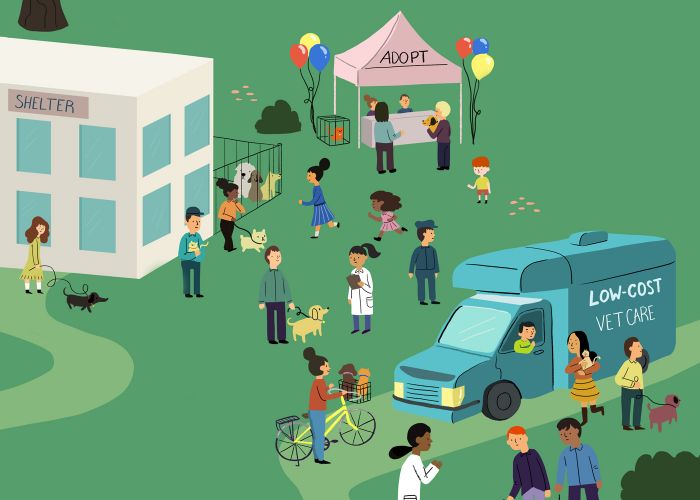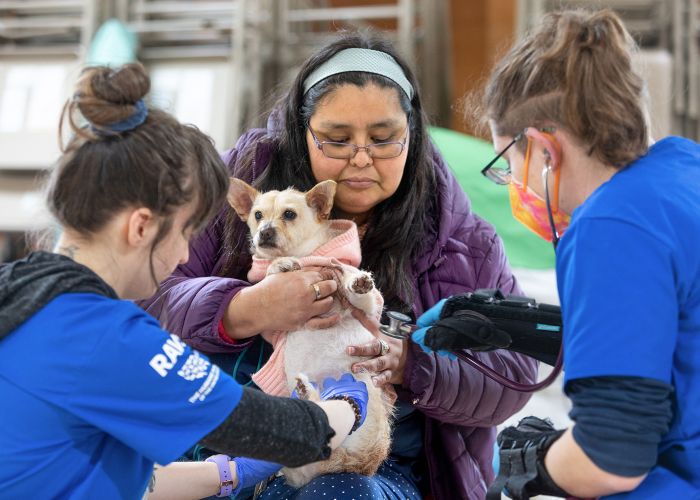Smart moves for winning grants
Foundation funding can take your programs from good to great, but it takes more than a big idea to walk away with the cash

You've got a terrific idea for helping animals—all you need is a lot of money.
You dash off an email to a deep-pocketed foundation, describing your vision and your lifelong love for animals. Three days later, a white van pulls up to your house. A film crew points their cameras toward you, and a handsome man presents you with flowers, balloons and a massive check.
Sadly, that’s not how grant funding works.
True, there are foundations that collectively give out millions of dollars each year to animal welfare causes. But there are also thousands of nonprofits competing for that money, and the process is more involved than sending an email, buying a lottery ticket or entering a sweepstakes. The good news is that, when done right, your chances of success are much higher than 1 in 2.4 billion.
So go ahead and fantasize about winning the lottery when you need a mental break from cleaning cages, feeding fosters or reviewing last month’s vet bills. Just make sure you also invest some time in developing a winning grant strategy.
Finding prospective partners
There are different types of grant-making organizations, including private family foundations such as Maddie’s Fund, corporate foundations like Petco Foundation and PetSmart Charities, and community foundations, which often fund a range of philanthropic work in their regions. All have specific areas of interest and are looking for organizations that can combine their money with boots-on-the-ground work to achieve shared goals.
Before you can identify foundations that are a good fit, think about the problems your organization exists to address. How do your core programs help you fulfill your mission? What is your current capacity, and what are your long-term goals? Do you need money to support general operations, or for a specific project, an event or a big-ticket item such as a transport van or clinic autoclave?
You likely have multiple financial needs and program goals, but knowing your priorities and having a clear vision of what you can achieve with additional funding will help you focus your research and draft a compelling proposal.
Next, boot up your computer and get ready to search out some likely prospects. Of course, you’ll want to look at the large grant-makers in animal welfare, but don’t forget about the lesser-known family foundations that support animal welfare projects, community foundations that serve your geographic area and corporate foundations connected to large employers in your region.
Fortunately, many foundation websites provide detailed guidelines for grant-seekers. Read the requirements carefully, taking note of the types of programs and organizations the foundation funds, geographic limitations and any other criteria. (Note that the vast majority of foundations only give grants to registered public charities, so if your group doesn’t yet have 501(c)(3) status, you’ll have a narrower pool of prospects.)
This initial legwork is crucial: If you’re raising money for a foster- based rescue group for cats, you don’t want to waste time submitting proposals to foundations that only fund municipal shelters, dog spay/neuter programs or organizations in a different state. Foundation board members don’t want to waste their time either, says Kimberlee Dinn, senior vice president of philanthropy at Humane World for Animals. Applying for grants your organization isn’t qualified for can leave a bad impression and lessen your chances for future funding.
Dinn, who started her fundraising career as a grant writer, has been on both sides of the grant-maker-grant-seeker relationship. As a board member of a small human health foundation with specific geographic and issue limitations, she helps review hundreds of grant requests each year. About 70 percent of proposals go in the trash, she says, simply because the applicants didn’t pay attention to the foundation’s programmatic and geographic limitations.
If the foundation doesn’t have a website or the information is vague, you’ll need to dig deeper. The Foundation Center (which recently merged with GuideStar to form the nonprofit Candid) boasts an online database with details on more than 140,000 grant-making organizations and the ability to filter by funding interests, geographic focus and other criteria. (While you have to pay to use the full database, many libraries and nonprofit resource centers provide free access.) You can also look at a foundation’s tax filings, available for free on sites like GuideStar, to view a list of grants the foundation has given in the past.
Personal connections can also help, especially when it comes to family foundations in your area, says Dinn. Find out if your board members or supporters know any of the foundation’s board members (also listed in its tax filings), and use those contacts to learn more about the funder’s interests. Even if they’re not interested in animal welfare, funders often network with other funders, so building relationships with local foundations can unearth some valuable prospects, Dinn says. “Sometimes the best leads I get are from other funders.”
Tip #1: Read the grant application carefully and look for key words or phrases you might want to emphasize in your proposal.
Writing a standout proposal
There’s no one-size-fits-all format when it comes to grant proposals, and every funder has its own requirements.
Some ask that you send a letter of inquiry (basically a one- or two-page summary of your request) before you submit a full proposal; many only accept applications at certain times of the year. Some foundations have online applications and even video tutorials to guide you through the process; others require that you mail paper copies (often with specific formatting instructions, including whether you can use staples or paper clips). The supplemental materials you provide with your application will also vary: One foundation may ask for a three-year strategic plan and a description of your board members’ qualifications, while another might want a copy of your adoption application and letters of support from clients or partnering organizations in your community.
The bottom line: You need to follow instructions.
At the Petco Foundation, the No. 1 mistake in applications is basic data entry errors and omissions, says Susan Cosby, director of lifesaving programs and partnerships. “About 20 percent of grants submitted have errors that don’t allow us to move forward.”
So proofread everything for spelling and grammar, double- check your math and make sure the numbers related to your organization’s annual income and expenses match the information in your Form 990 or financial statement. By paying attention to the details and making sure your application is complete and accurate, you’ll be ahead of the competition.
In a typical grant proposal, the narrative portions include a statement of need (the reason for your request), a project description (how your efforts will impact the problem) and an organization description (why your nonprofit is well-situated to tackle the problem). Use local facts and statistics, and include a compelling real-life example to illustrate the need. “You don’t have to be William Shakespeare, but you have to be factual, concise and complete,” Dinn says.
You’re not telling your story the same way you would to a donor, adds Cosby. “It’s great if you tell us the story of Fluffy the cat and her road to recovery, but what we want to know is how can we make the greatest impact with our funds. If Fluffy was one of 1,500 animals we [would be able] to help, that’s telling the story in a better way.”
This is also the place to emphasize the aspects of your program that appeal to the foundation’s focus. “It’s not just what’s your goal and passion, but understanding your funder, too,” says Christine Robinson, CEO at The Animal Foundation, an open-admission shelter in Las Vegas. For example, if you are pitching a proposal to a foundation that funds programs for the elderly, you’ll want to describe how your proposal to provide discounted veterinary care for the pets of low-income seniors will improve their owners’ quality of life.
Another way to ensure your proposal rises to the top of the pile is by highlighting partnerships with other organizations, or even submitting a joint proposal. Many foundations view partnerships as a sign that your group is looking at the big picture and taking a holistic approach to the problem. At PetSmart Charities, “we really look for collaboration and collaborative projects,” says director of programs Lindsay Del Chiaro.
If you don’t have formal partnerships, you should still describe how you work with other animal welfare groups by referring clients or sharing resources, and explain how your programs complement— rather than duplicate—the work of other nonprofits or government agencies. Otherwise, it could be painfully obvious to funders that organizations in your region aren’t communicating, says Del Chiaro, who recently received separate applications from 19 animal welfare groups in the same community “to do about the same work.”
Communicating with numbers
No matter how eloquently you state your case for funding, the numbers in your grant proposal are just as important as the words.
One of the first numbers you’ll need to figure out is the amount of your request. Some foundations are upfront about the available funding levels in their guidelines; for others, you can typically get an idea by looking at the size of their past grant awards.
But some foundations have a wide range of giving levels, from $500 to $1 million or more. In this case, you want to be realistic. If your rescue group’s annual income is $25,000, you’re unlikely to get a $100,000 grant.
Grants are just one part of a healthy mix of revenue, says Dinn. Think of foundations not as fairy godmothers but as business partners who are looking to supplement your other sources of funding.
Del Chiaro encourages first-time applicants to start with a small ask, such as an event grant, which will allow you to build a history with the foundation before submitting a proposal for a strategic program with a more significant investment of funds.
Whatever the size of your request, nearly every grant-maker will ask for a project budget detailing the program’s anticipated costs (both direct and indirect) and the sources of funding, which may include grants from other foundations. According to “Introduction to Project Budgets” by GrantSpace (see Resources at right), your budget should “be a mirror reflection of your proposal.” If your proposal and budget tell different stories, “that’s a red flag to funders that your planning is weak and you may not have thought everything through.”
Keep in mind that although some foundations will fund salaries, administrative overhead or other capacity-building expenses, many will only contribute to direct program costs. So, for example, if you pitch a proposal to double your number of spay/neuter surgeries but need to hire a program administrator to reach that goal, you’ll need to describe how you will fund that salary.
Along the same lines, you should be prepared to describe your plan for sustained funding after the grant money is depleted. Few foundations are able to fund any program in perpetuity, says Del Chiaro, and they want to know how you are going to “ensure that this project is going to stay in your budget ... so you can continue to carry out that good work.”
At the end of the day, your final grant application, with all supporting materials, should showcase your organization’s stability, professionalism and ability to fulfill its promises.
“Have some passion in your ask,” Robinson advises, but remember that “rainbows and unicorns and a big dream list without a business plan or model doesn’t sell.”
Tip #2: Describe the project in an interesting and compelling way, using accurate facts and local statistics.
Sustaining your partnerships
Congratulations, the foundation approved your request, and a check is on its way!
As you enter the last phase of the grant cycle, your focus will shift to nurturing the relationship with your funder and ensuring that you meet your goals.
Read the grant award letter carefully and take note of all reporting requirements and deadlines. For example, a foundation that is helping to fund your first mega-adoption event may request event photos and testimonials from adopters, and you’ll need to add these to your to-do list for the big day.
Be sure to thank your funder (with a phone call, letter or email, depending on their preference) and recognize the foundation in the ways it requests, paying attention to any instructions regarding its name and logo.
Nearly every funder will require a formal follow-up report in which you describe the results of your program and how the funds were spent. “It’s super important to keep track of results to show the impact of that giving,”
Robinson says, and by fulfilling your commitments, you’re keeping the door open for future funding. Robinson has learned a lot about the value of foundation partnerships in recent years. When she became CEO of The Animal Foundation in 2007, the shelter “had so much to do on basic animal care,” she says; applying for grants simply wasn’t a priority.
Several years later, the shelter was in a better position and looking for ways to increase its lifesaving impact. In June 2015, The Animal Foundation announced Mission: Possible 2020, an initiative for saving all healthy and treatable animals through programs focused on community cats, surrender prevention, low-cost spay/neuter for owned pets, adoption promotions, transfer partnerships, and medical care for sick or injured pets. To make all this possible, the organization would need to raise an additional $2.2 million a year.
Robinson and her team crafted a plan and began reaching out to funders. We were “uber-detailed on how the programs are going to work, here’s how much it will cost, with really well-thought-out program analysis and development,” she says.
The Petco Foundation committed $600,000, and that early success “made all the difference in the world,” Robinson says. “It showed our community and board that a well-respected organization was willing to believe in us.”
A few months later, the city and county, which had previously only funded sheltering costs, allocated over $1 million to the initiative’s prevention programs. Robinson kept pitching her plan, and the money kept coming in, including large grants from Maddie’s Fund, Best Friends Animal Society, local family foundations and additional funding from Petco. There’s still progress to be made, but shelter intakes have dropped by nearly half, live-release rates have increased dramatically, and these tangible payoffs are keeping the foundations happy.
Looking back, Robinson says that while writing those first grant proposals was a challenge, it became much easier over time. “It’s definitely a domino game. The better you do, the better you do. People want to be part of a winning solution.”
Tip #3: When crafting a proposal, don’t focus on your organization’s needs but the needs of those served. Use real-life examples that hit home.







